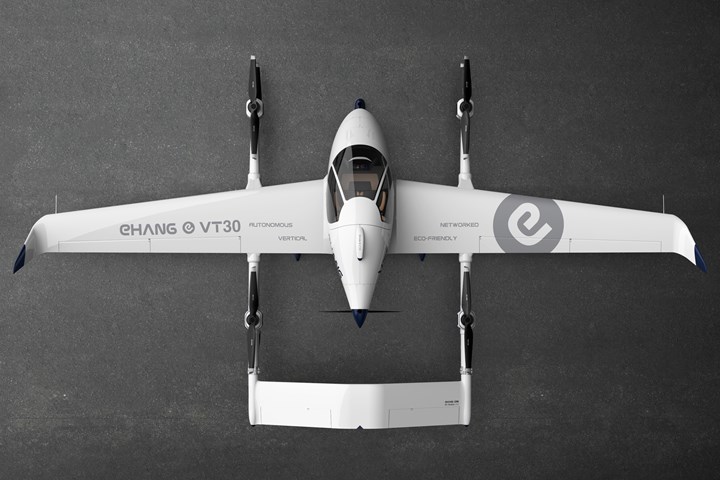EHang reveals long-range composite autonomous aerial vehicle
Further expanding its UAM services, the passenger-grade VT-30 is designed for zero-emissions intercity transportation up to a distance of 300 kilometers.

All photo credit: EHang
On May 26 EHang (Guangzhou, China) revealed its new type of electric passenger-grade autonomous aerial vehicle (AAV), the VT-30, said to be the first in EHang’s product suite that is designed for intercity transportation. Incorporating composite materials, VT-30’s hybrid structure is designed to travel a distance of up to 300 kilometers with a designed flight time of up to 100 minutes and is designed as a safe, convenient, efficient, eco-friendly and intelligent air mobility solutions for intercity travel. As EHang’s long-range flagship product, VT-30 will complement EH216, a product focusing on intracity air mobility, to further expand the air transportation network and improve the future urban air mobility (UAM) ecosystem.
EHang reports that VT-30 has a streamlined fuselage with a combined lifting rudder surface at the tail. Equipped with eight propellors on both sides, it has a pair of fixed wings, and a propelling propellor at the rear, which are designed to achieve a maximum balance of hybrid lift and push. Its design is said to enable VT-30 to enjoy the advantage of both vertical and taxi take-off and landing modes, while satisfying the need for longer distance and flight time. Unlike conventional fixed-wing aircrafts, the company adds, it saves the runway for take-off and landing. Moreover, the tri-redundancy fly-by-wire control system can be flexibly altered into multiple modes, implying a much higher safety level for the aircraft.
VT-30 is geared towards intercity travels among city clusters (such as the Guangdong-Hong Kong-Macao Greater Bay Area, Yangtze River Delta, Bohai Rim, etc.), as it is able to carry two passengers from one city to another. VT-30 is a zero-emissions and low-noise aircraft, fully aligned with EHang’s principle of green travel. Compared with conventional intercity transportation modes, VT-30 is expected to provide more efficient, environmentally friendly and low-cost solutions to urban dwellers as well as expanding the capacity of existing UAM services.

So far, EHang says that VT-30 has conducted vertical take-off and landing (VTOL), power system and other tests. Moving forward, EHang will continue to conduct various tests and optimizations under different environment conditions, while continuously improving AAV safety and stability, with the goal of accelerating long-distance AAVs to be used in various scenarios such as air commuting, aerial sightseeing and aerial logistics.
“Our passenger-grade AAV EH216 is already fully equipped to travel in the cities with its lightweighted and streamlined structure, and the launch of the VT-30 provides a powerful complement to the intercity air traffic network by meeting needs for covering longer distance,” says Mr. Huazhi Hu, founder, chairman and CEO of EHang. “Moving forward, these two product series will be used as core development for a service-oriented operations strategy to improve the safety, duration and capacity for carrying both passengers and goods. We will work continuously to obtain regulatory certification for our various AAV products, including the VT-30, and provide a more convenient and efficient public UAM operational services.”
Related Content
-
Composites end markets: Pressure vessels (2024)
The market for pressure vessels used to store zero-emission fuels is rapidly growing, with ongoing developments and commercialization of Type 3, 4 and 5 tanks.
-
Paris Air Show 2023 highlights
The Paris Air Show, one of the largest aerospace trade shows in the world, returned for the first time since 2019 and proved that the global aviation industry industry is very much alive and kicking.
-
Honda begins production of 2025 CR-V e:FCEV with Type 4 hydrogen tanks in U.S.
Model includes new technologies produced at Performance Manufacturing Center (PMC) in Marysville, Ohio, which is part of Honda hydrogen business strategy that includes Class 8 trucks.
















